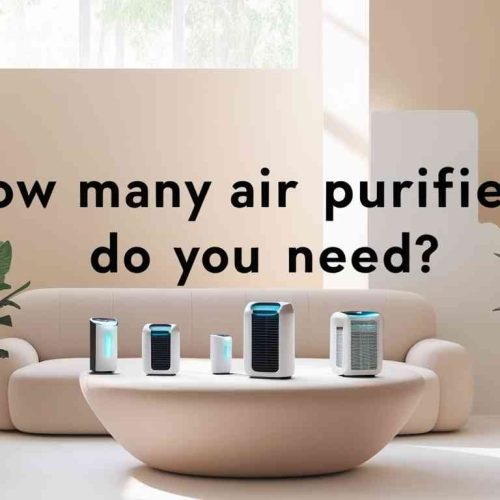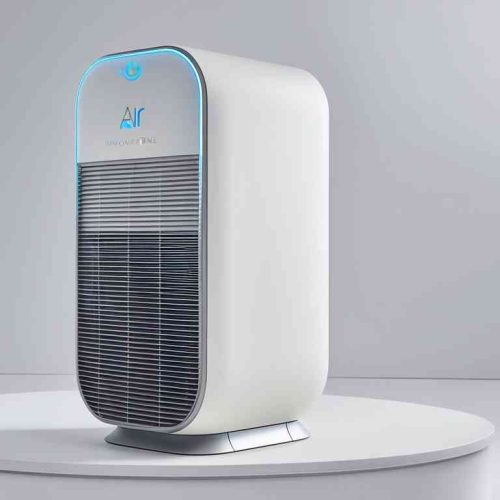Where there is a possibility of getting exposed to Asbestos at home, for example, during renovation, the focus shifts to keeping the indoor environment safe and sound. Want to understand how air purifiers Suitable for Asbestos can deal with fiberglass in the air? Or how to get the most out of them? This article encompasses everything. This text will explain the significance of HEPA filters, emphasize the need for professional asbestos-removal services, and give a step-by-step guide to choosing the right air filters to avoid potential problems related to air pollution within the premises.
What Is Asbestos and its Impact?
Asbestos is a natural stone incorporated in several ACMS, including insulating, shingles, and flooring. Its application was favored for its high resistance to extreme temperatures until its harmful effects were realized. Prolonged exposure to Asbestos is a risk factor for many respiratory diseases, such as Mesothelioma, lung cancer, and asbestosis, among others. This recognition of the asbestos health threat thus enforces the requirement for those who work with Asbestos to do it with care and ensure proper air protection indoors.
How Air Purifiers Work Against Asbestos
Although air purifiers can collect airborne particles or contaminants in the air, not all are qualified to be effective against Asbestos. Models with true HEPA filters or high-efficiency particulate air technology (HEPA) can capture 99.97% of particles. As small as 0.3 microns are the best options for penetrating Asbestos. Asbestos fibers range from 0.7 to 90 microns, and HEPA filters effectively capture these dangerous fibers, ensuring a safe indoor environment.
Choosing the Right Air Purifier for Asbestos Mitigation
Selecting an air purifier involves understanding critical specifications and ensuring the unit can manage Asbestos effectively.
Key Features to Look For
- HEPA: One of the key characteristics to keep in mind is the genuine likeness of a HEPA filter. Which can prevent penetration of small particles, otherwise referred to as “HEPA-type” filters.
- Clean Air Delivery Rate (CADR): Apart from this, a high CADR will assist in sites at risk of electrical sanitization. Those in buildings that are at high risk of asbestos contamination.
- Room size coverage: The coverage area of a room’s air purifier is equally important in terms of effectiveness.
- Filter Maintenance Indicators: A filter change is only the beginning. Having a set schedule helps maintain the efficiency of the air purifier and air assurance indoors at all times.
Additional Features for Enhanced Air Quality
- Activated Carbon Filter: The asbestos-containing membranes in some HEPA filters are helpful. However, an activated charcoal filter does allow for the inclusion of odor.
- Portable Air Purifiers: Air purifiers that are small and portable can be transferred from room to room. Thus, we can deal with a more specific area that has Asbestos.
- Air Purifier Noise Level: This factor is crucial when the air purifier is placed in a residential setting. Pick the units that have low decibel levels to improve comfort.
Point of View on Using Air Purifiers Suitable for Asbestos Control
Even with HEPA filters that remove most airborne asbestos fibers, they still have limitations because they can’t eliminate bonded asbestos particles trapped within walls or insulation. To eradicate the source, the help of an asbestos professional is a requisite.
Why Hire Asbestos Removal Specialists
Hiring people for asbestos abatement is very important because such people are trained and equipped to handle Asbestos properly. This procedure comprises the following:
- Assessment and Analysis: Professionals fully assess areas suspected of contamination and undertake proportional laboratory investigations.
- Isolation: Negative-pressure ventilation systems restrict the dispersal of contaminants in the air.
- Sophisticated Ways of Removal and Disposal: The regulated laws covering disposals securely collect and take away the materials.
- Testing For Air Quality: Tests carried out after the process confirm the quality of the inside air and whether there are any asbestos fibers present.

The Function of Air Filters after the Removal Process
There comes a time when air filters may distinguish between life and disease. Therefore, even after professional asbestos surgery, if airborne conditions are maintained, houses are beautified. An air filter equipped with a HEPA filter takes care of the remaining pollutants and particles responsible. It makes the indoor atmosphere unclean and contaminating.
How to Properly Use Air Purifiers When Dealing With Asbestos
- Cover The Contaminated Places: To keep areas possibly harboring Asbestos, cover the rooms with plastic materials.
- Wear a Mask: Tightly fitted N95 respirator and protective clothes should be worn. It should be worn when exposure to the contaminated sites is unavoidable.
- Don’t Vacuum The House: We should use a HEPA vacuum cleaner. The normal vacuum makes the presence of Asbestos.
Review of Asbestos Removal Air Purifiers
Model Features Room Size Coverage Noise Level
Blueair Classic Series True HEPA filter, quiet operation Up to 775 sq. ft. Low
Honeywell HPA300 Affordable, powerful CADR, HEPA filter Up to 465 sq. ft. Medium
Dyson Purifier Cool™ TP07 HEPA filter with air quality monitoring Up to 800 sq. ft. Low
Routine Maintenance is Necessary
To retain potency against asbestos fibers, you must properly maintain the air purifier, which entails the following:
- Installing routine filters: Filters should be checked monthly for cleaning or replacement. HEPA filters need to be changed in six to twelve-month intervals depending upon their intensive usage.
- Cleansing the Unit: It is also advisable to wipe the exterior of the air purifier and inside the intake vents owing to external dust and debris that may settle on the unit.
- Take some Notes: Patients should note down when they last changed the filters and the date of the most recent maintenance for the air purifier and other components. This is vital as it will track when each part of the air purifier was last serviced, ensuring it functions at optimal capacity.
The Use of Air Purifying Technologies for the Future
New trends in air purification technologies are arising due to an increasing demand for a healthy indoor climate. Among them, the furthering popularization of:
- Smart Air Purifiers: Employ sensors to assess the air quality and control the level of filters accordingly without manual operations. Connecting them to mobile phones to receive alerts and status when required is possible.
- UV-C Light Integration: Some models of air depurators combine USEPA filtration with UV-C light to destroy germs.
- Eco-Friendly Filters: Manufacturers are taking initiatives to include biodegradable filter materials and develop energy-efficient models.
Tools for Managing Community Resources for Asbestos Awareness
Individuals who have previously encountered asbestos materials. Those who are in search of help can benefit from a variety of local community resources, including:
- Local Health Departments: local health departments provide the resources needed for asbestos testing and safe removal practices.
- Environmental Protection Agency (EPA): The EPA provides tips about the risk of Asbestos. They are safe control for this hazard in buildings and houses.
- Non-Profit Organizations: Lung health organizations and asbestos awareness organizations can offer support, self-help groups, education, and lobby for safer policies.
Conclusion
An asbestos air purifier with a HEPA filter can further ensure safer indoor air quality, especially if there is a risk of Asbestos. Moreover, for complete protection, the professional removal of Asbestos remains essential. Therefore, knowing how to find an air purifier right for the job and when to reach for expert services will keep the risks to home and family at a minimum. Ultimately, as long as you know what steps to take, there is no reason to be concerned regarding the invisible presence of Asbestos and its menace to your house and health.

FAQ
Q1: Can an air purifier help eliminate Asbestos from my house?
A1: No. An air purifier device has no asbestos abatement technique, as it can help reduce the number of asbestos fibers.
Q2: Which filter will capture Asbestos?
A2: Asbestos fibers ought to be captured using a true HEPA filter.
Q3: When is the HEPA filter of the air purifier thesed?
A3: For everyday use, changing the air purifier every six months to a year is okay. Regular changes will ensure the air purifier’s maximum effectiveness.
Q4: Are there additional technologies that can assist with the management of Asbestos?
A4: Professionals use negative-pressure air systems to manage airborne dust particles during abatement.
Q5: Can air purifiers also clean out other pollutants besides Asbestos?
A5: Yes, HEPA filters actively capture pollen, dust, and mold spores, enhancing the air quality and safety within a building.
Q6: What action would you take if you suspected that Asbestos could be in your house?
A6: Reach out to an expert in asbestos abatement and refrain from any activity that could disrupt any materials.
Q7: Is a portable air purifier recommended for larger rooms?
A7: For optimal performance in larger areas, seek a portable air purifier with a high CADR rate, as these devices work best in small spaces.
Q8: In what ways do air Purifiers Suitable for Asbestos facilitate respiratory functions?
A8: Lung ailments will be kept at bay as the air will be free from contaminants and air pollutants.
Q9: What are the effects of Asbestos contamination?
A9: Possible signs include Drywall, among other materials that are breaking apart, and old ASN insulation of a bulky kind that decays. And visible asbestos fibers that are loose – as this suggests a chance. It would be prudent to assess it visually by an expert third party.
Q10: Are air purifiers Suitable for Asbestos effective enough for use during professional abatement?
A10: Yes, they effectively manage airborne particles, but experts should enclose the area and handle the abatement process.












